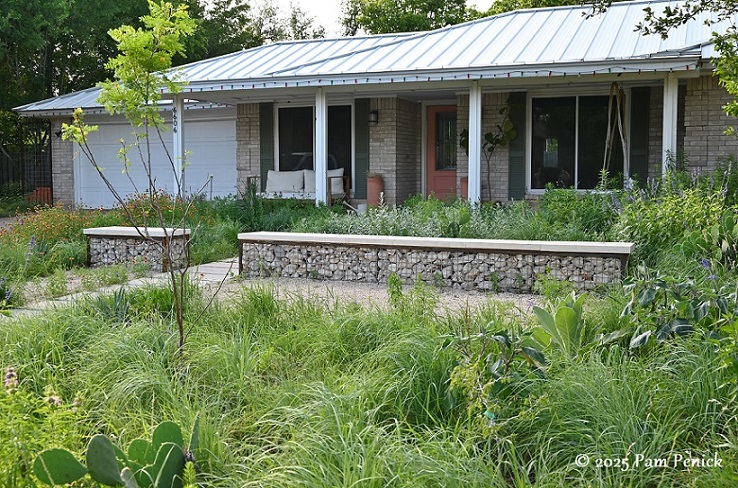May 07, 2025
This spring, Danny Bravens, owner of Native Son Gardens, gave a Garden Spark presentation about replacing traditional thirsty turf with low-water, densely planted, native prairie plants — the kind of transformational work he does every day for homeowners (and for schools through the nonprofit Plant Community). The idea, he says, is to plant so thickly that opportunistic weeds are shaded and crowded out.*
Grasses grow quickly to fill out these prairie gardens, with flowering perennials intermingling to provide seasonal color and pollinator fuel. Shrubs, shrub-adjacent plants (yucca, agave, prickly pear, hesperaloe), and trees offer additional structure for year-round interest and wildlife habitat.
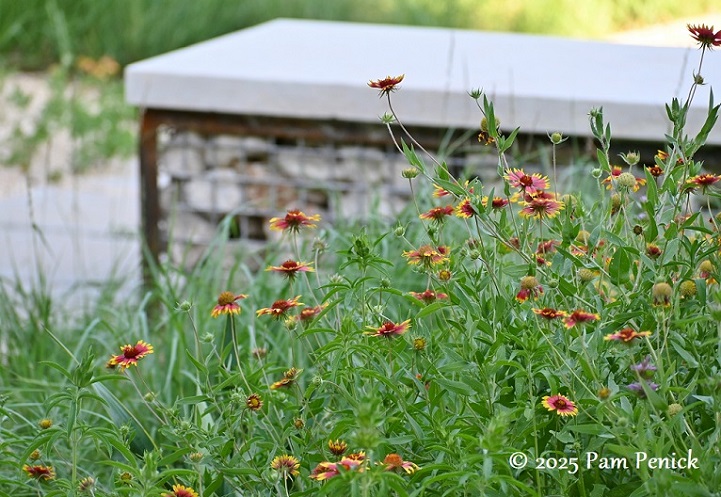
The density of planting shades the earth, helping to preserve soil moisture. In addition, prairie grasses send roots deep into the soil to seek out water — and they can soak up heavy rainfall when it comes, slowing runoff. In combination, Danny says, this allows the garden to be largely self-sustaining in terms of watering (except for newly planted plants, which always require water to establish).
Front-yard prairie
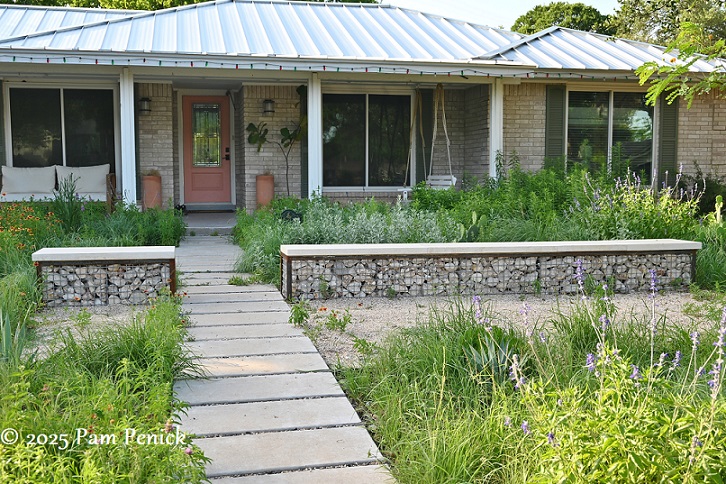
I was eager to see how Danny has applied these concepts in his own home garden, and last Sunday I had the chance. At Danny’s northwest Austin home, which he and his wife purchased in 2020, what was formerly lawn with tired foundation plantings is today a grassy prairie garden sprinkled with wildflowers. A low gabion wall topped with slabs of Lueders limestone creates structure, seating, and a delineation of the front yard’s public vs. semi-private spaces.
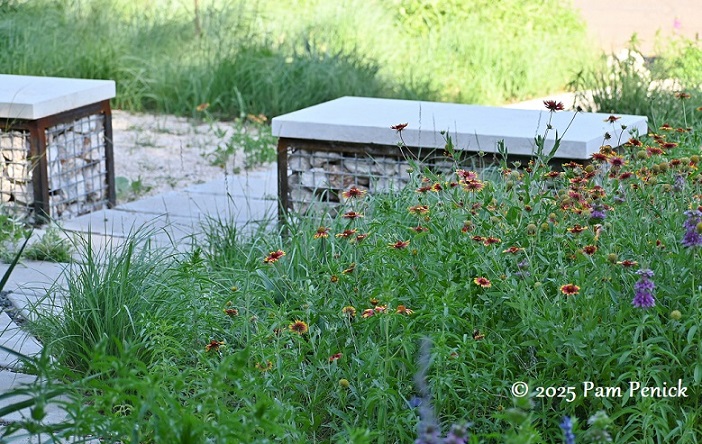
In early May, blanketflower and horsemint dominate the flowering mix. In a few weeks, purple coneflower and giant coneflower will take over, Danny said.
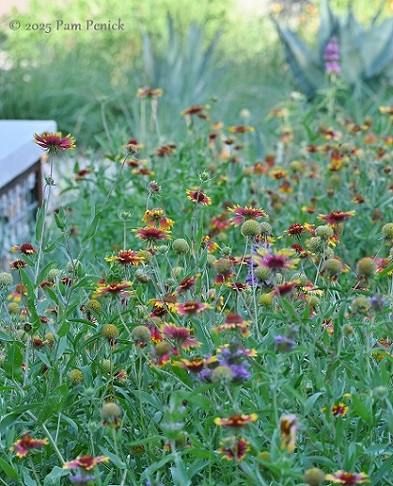
As we were looking at the lushly planted garden, Danny said something that stood out: “When I see a weed, I think, ‘I don’t have the right plants planted there.’ The right plants will crowd out weeds.”
It’s a better way to think about weeds, isn’t it? Instead of trying to drive you insane, weeds are telling you something important: you have open space that needs to be filled. And if you don’t do it, the weeds will. Once you figure out the right plant community for a given space and achieve maximum plant density, weeds can’t compete.
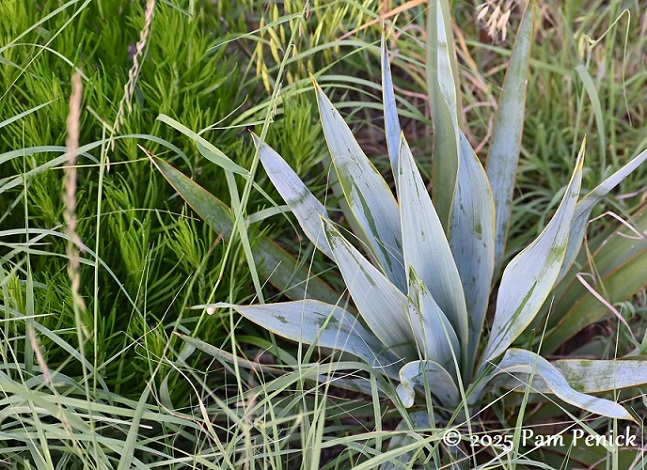
Paleleaf yucca’s glaucous foliage pokes up among the grasses.
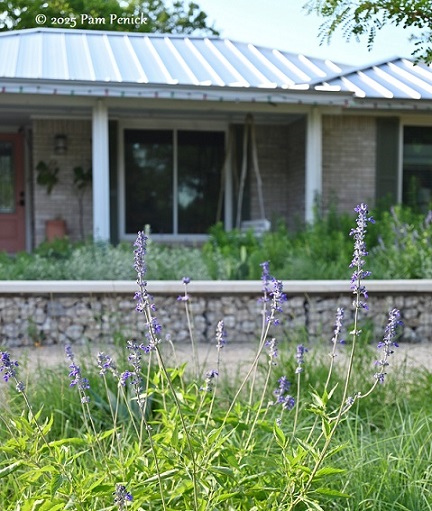
Mealy blue sage adds more silvery blue.
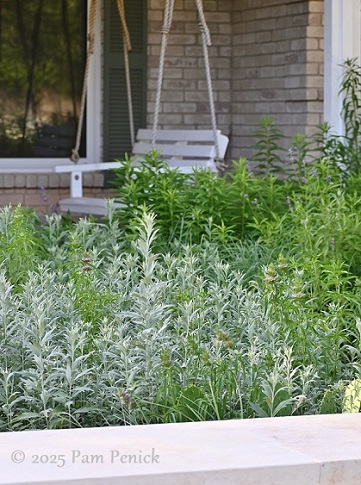
Silvery native artemisia (Artemisia ludoviciana) threads through the garden. Cultivar ‘Silver King’ is commonly seen in Austin gardens. It’s an aggressive running plant, but Danny rarely waters, which slows its roll.
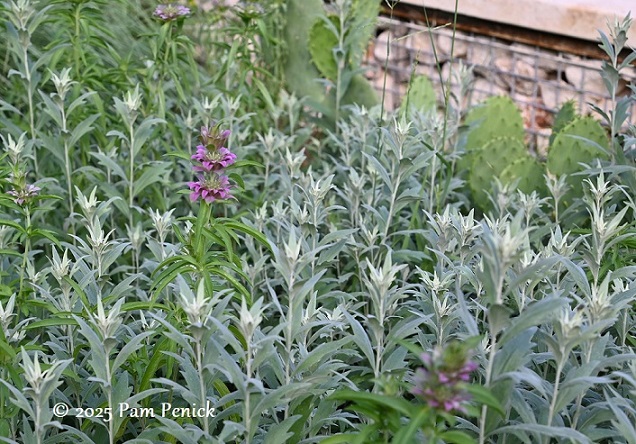
Pretty, right? Do you dare?
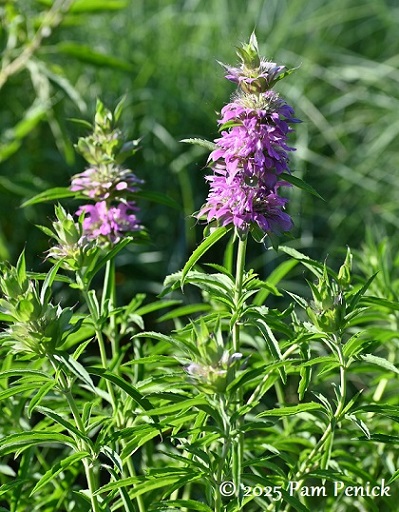
Horsemint, aka lemon beebalm
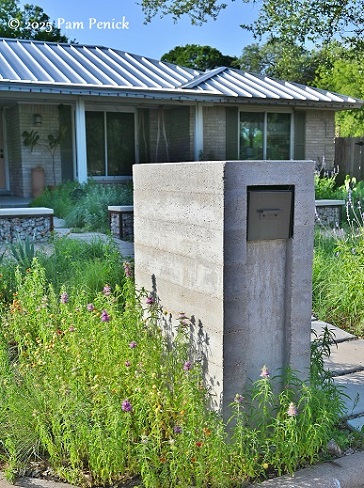
A board-formed concrete mailbox adds industrial-contemporary style.
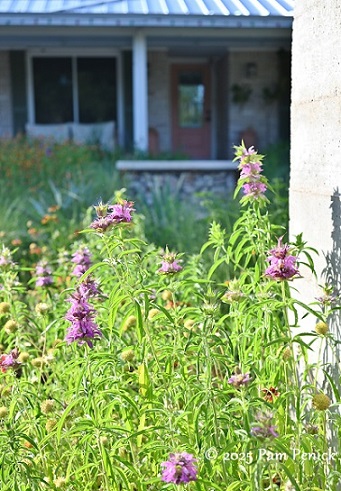
Horsemint around the mailbox no doubt brightens the mail carrier’s day.
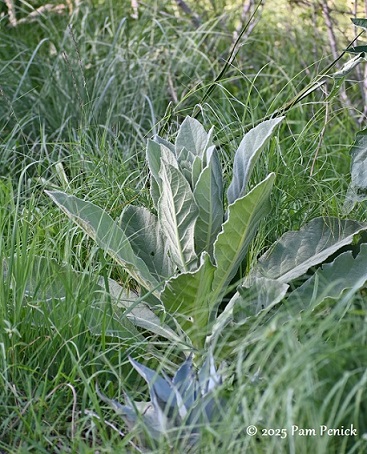
Silver-leaved mullein — nonnative but well adapted — splays fuzzy, broad leaves.
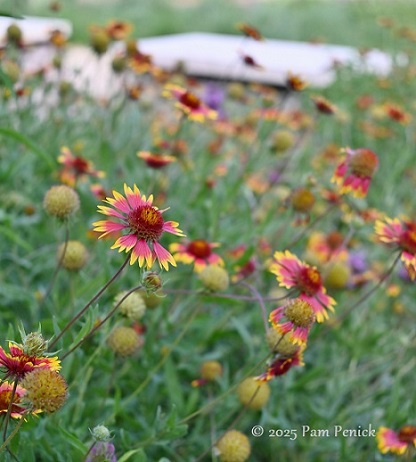
Red-and-yellow blanketflowers bob on slender stems.
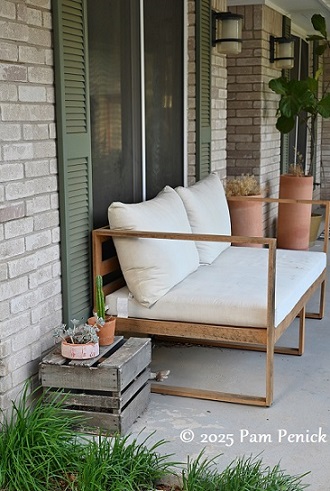
An inviting porch runs across the front of the house, with sofa and swing seating.
Back-yard shade garden
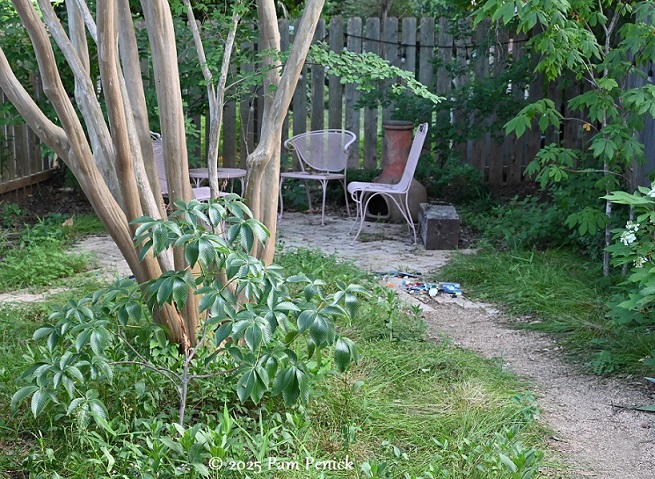
Just inside the fenced back yard, a crape myrtle shelters a small patio with dusty-pink garden chairs. Sedge (Danny thinks it’s probably Carex leavenworthii) makes a grassy mat under the tree, keeping weeds at bay. A red buckeye is getting established in the crape myrtle’s shade.
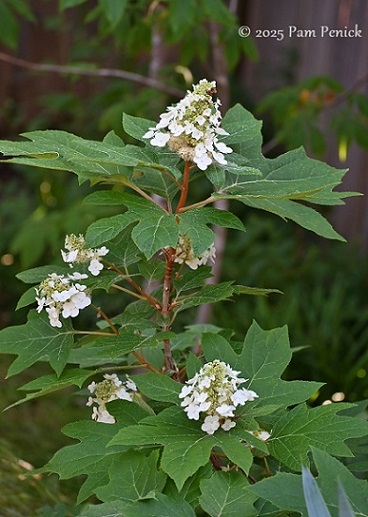
Oakleaf hydrangea and paleleaf yucca thrive in a shady strip along the fence.
Prairie garden and patio
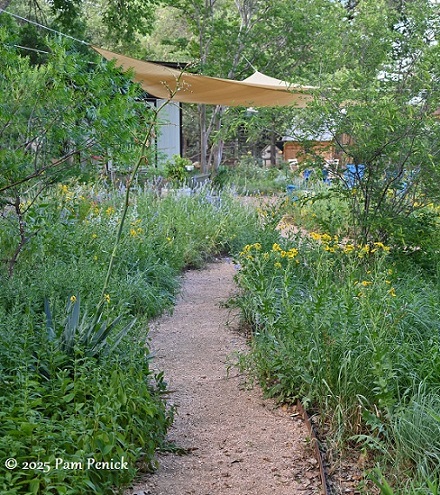
Danny’s backyard is wedge-shaped, with the widest space at the far end. A gravel path curves through sunny, meadowy beds of salvia and Engelmann’s daisy, leading toward a patio sheltered by a shade sail.
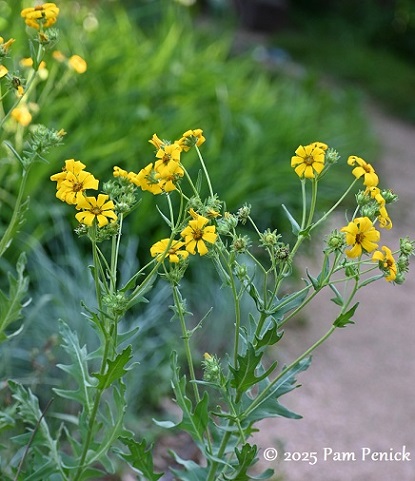
Engelmann’s daisy
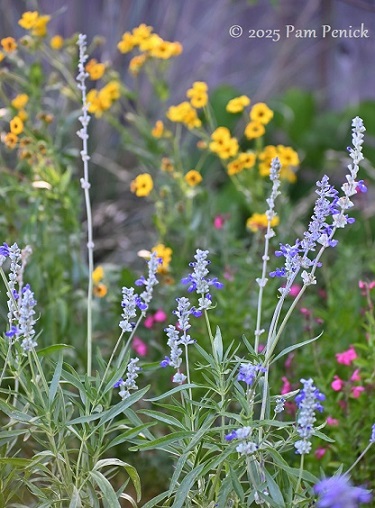
Mealy blue sage
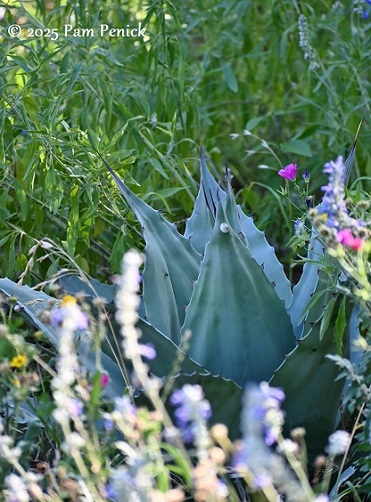
A few silver-blue whale’s tongue agaves poke up here and there.

Looking back along the path
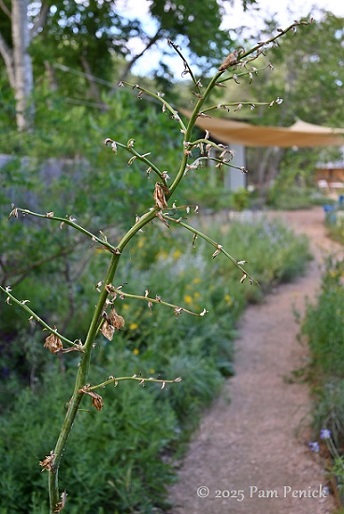
And looking ahead, through the skeleton of a yucca bloom spike
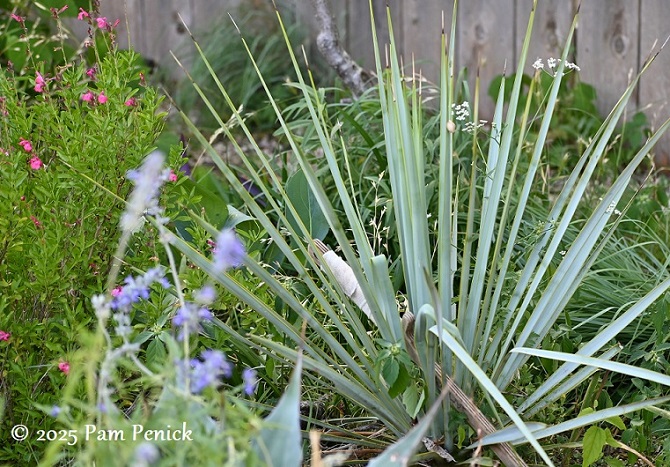
Yucca starburst amid the flowers
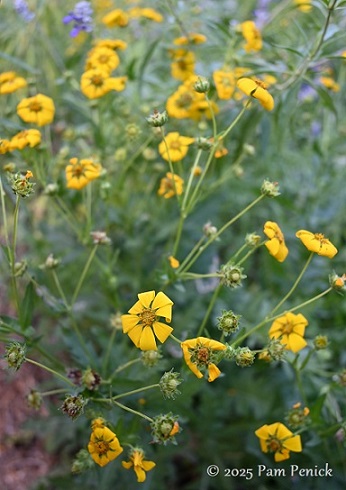
More Engelmann’s daisy. The curved-down petals intrigued me — a response to heat or drought, I expect.
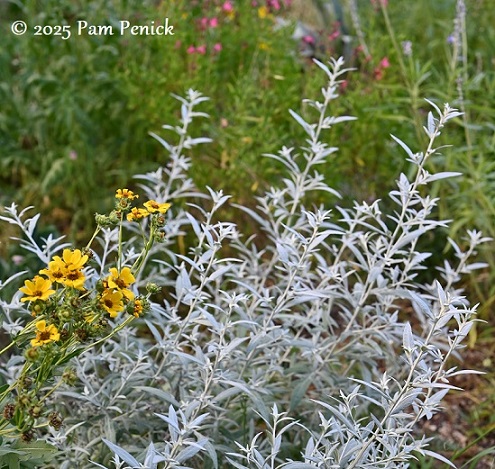
Native artemisia and Engelmann’s daisy
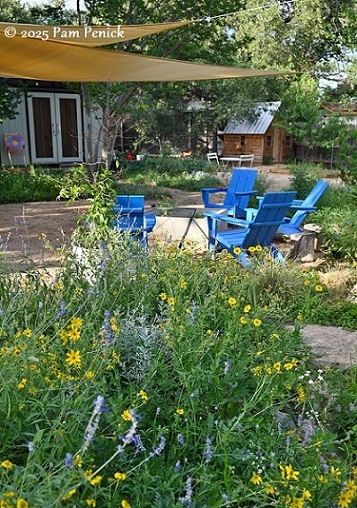
A large gravel patio with a board-formed concrete fire pit occupies the center of the garden, making a welcoming focal point from all parts of the yard.
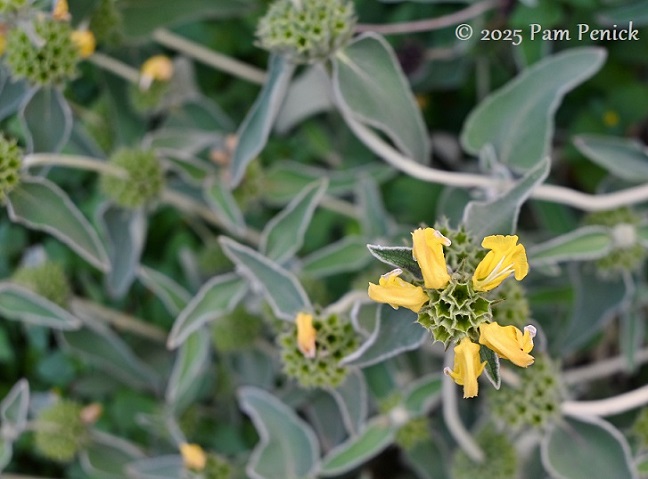
Jerusalem sage
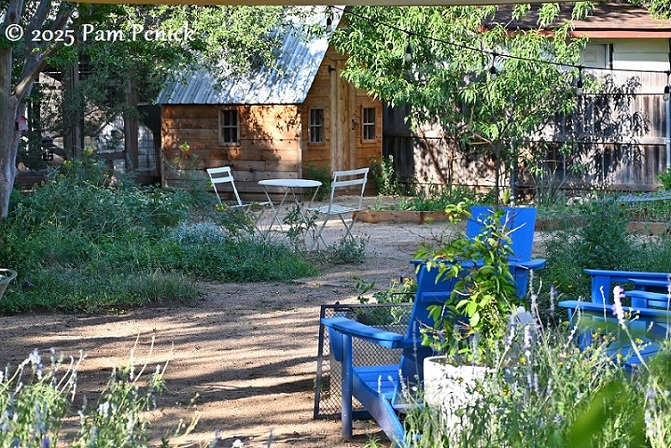
Beyond the patio, a handsome henhouse offers stylish digs for the Bravens’ backyard flock.
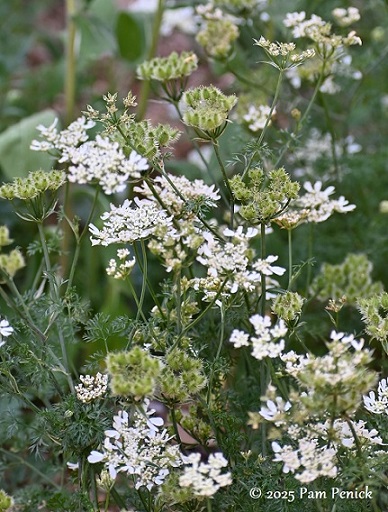
Orlaya, an annual that Danny’s wife, Shalyn, is growing
Backyard chickens
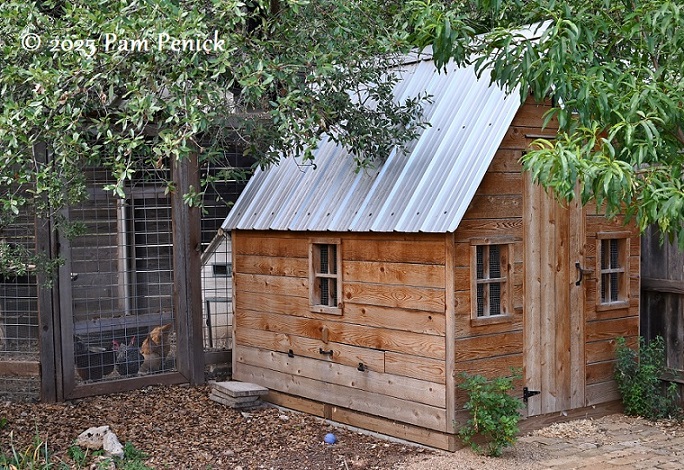
A flock of chickens enjoys the fenced yard behind their coop.
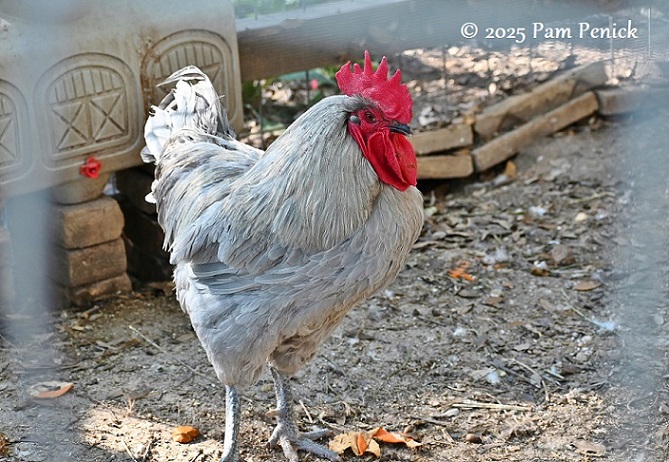
Even a couple of roosters
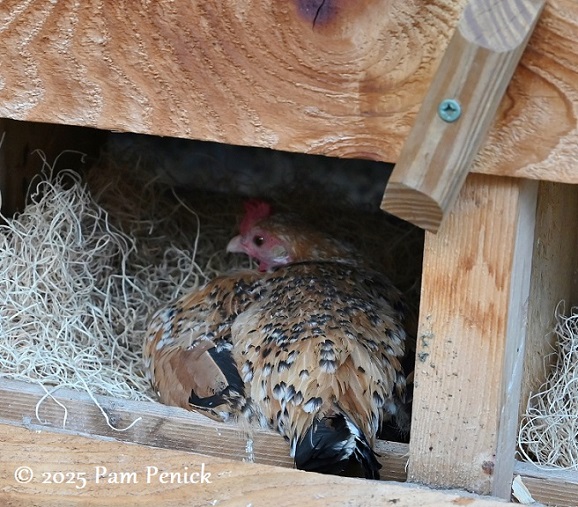
This little hen was broody, sitting on eggs to try to hatch them.
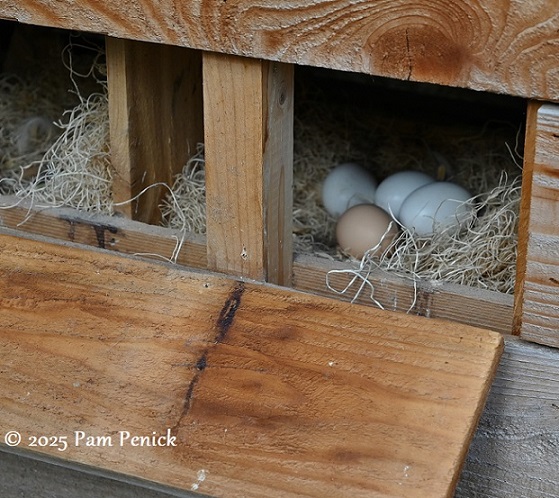
Other eggs were ready for gathering.
Shalyn’s cutting garden
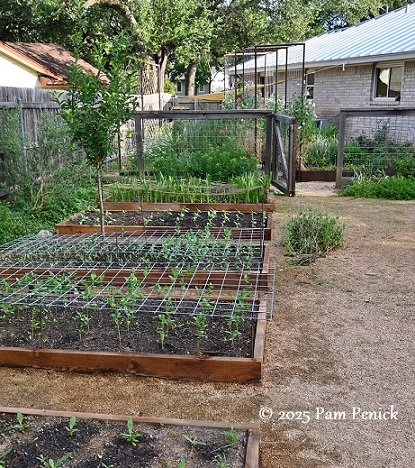
Shalyn has her own plant-based business called Bravens Backyard. She grows flowers from seed for cutting and turning into bouquets, which she sells by special order or subscription. These raised beds are planted up with her flowers.
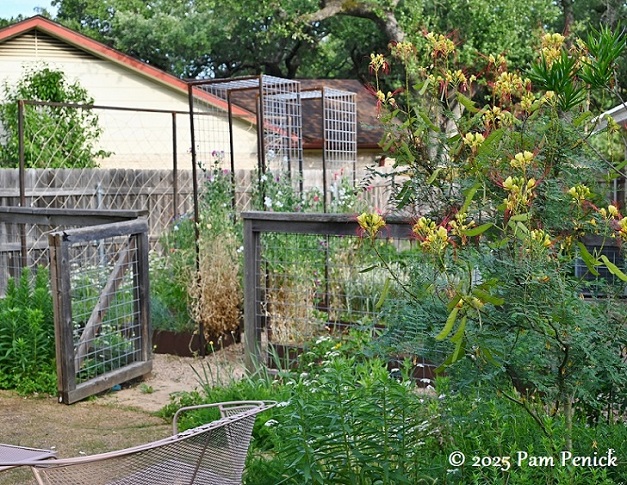
A fenced side yard features more raised beds and hog-wire trellises. In front, hardy bird-of-paradise (Caesalpinia gilliesii) is in red-and-yellow bloom.
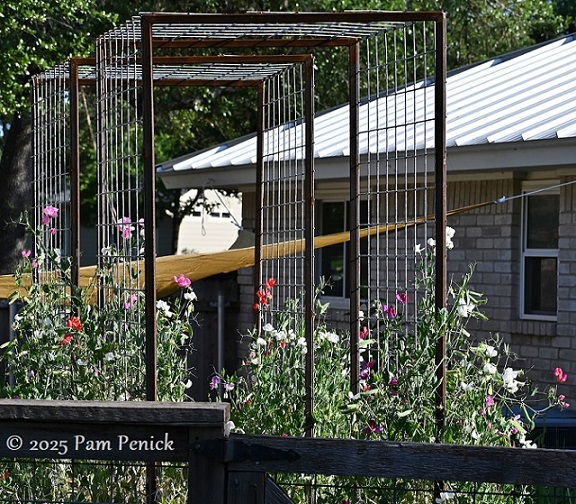
Hog-wire trellises support sweet peas right now.
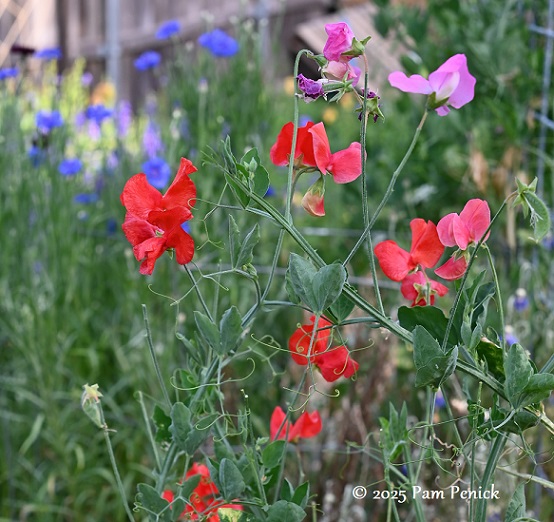
So fragrant!
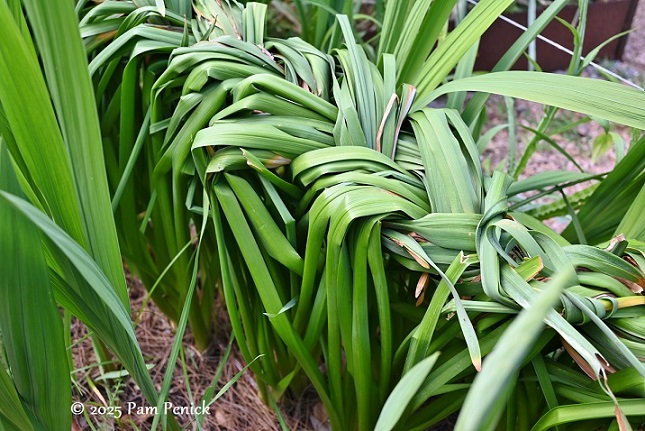
Braided foliage of spent bulbs
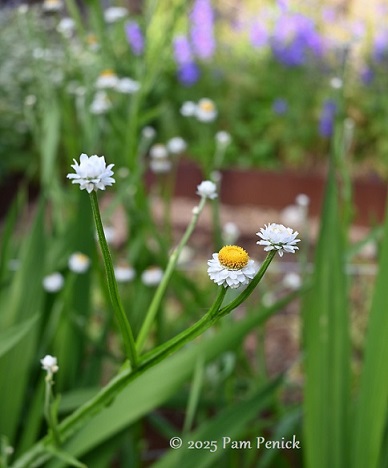
Winged everlasting (Ammobium alatum), a sweet little flower I’d not seen before
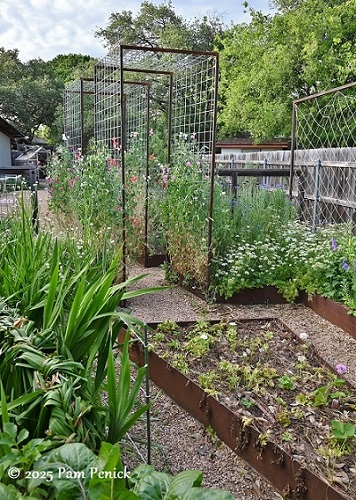
The cutting garden
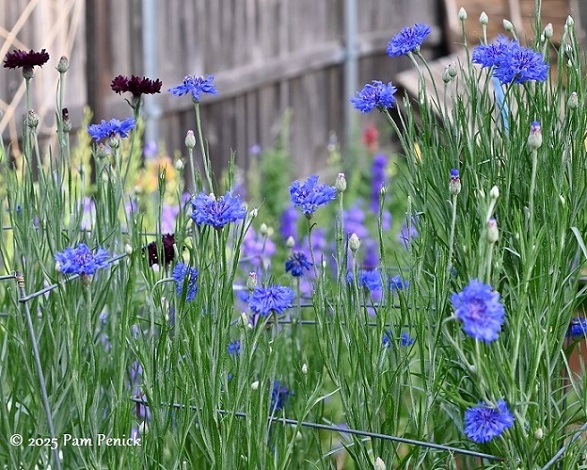
Cornflower
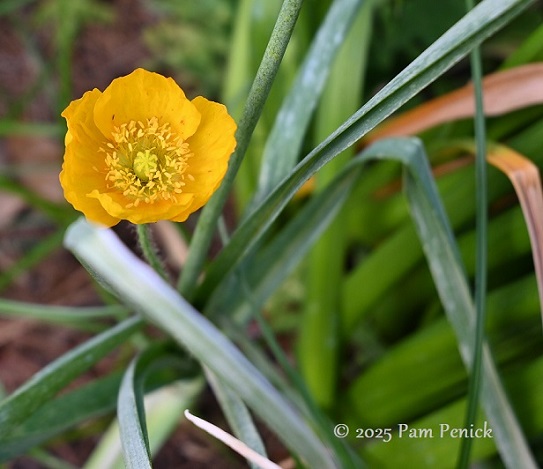
Poppy
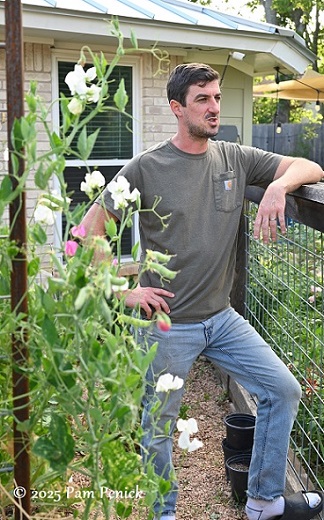
Danny and Shalyn are both putting their horticultural talents to work and making Austin a “greener,” more beautiful city.
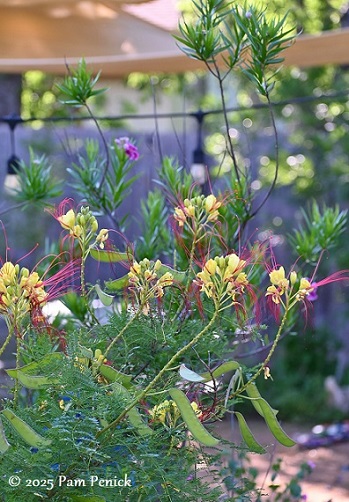
Hardy bird-of-paradise
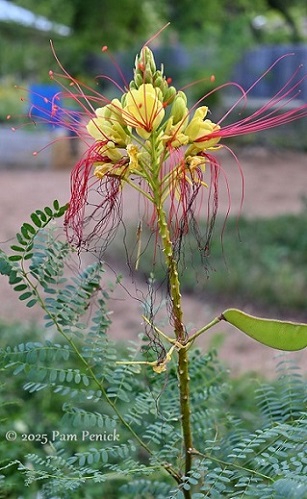
One more
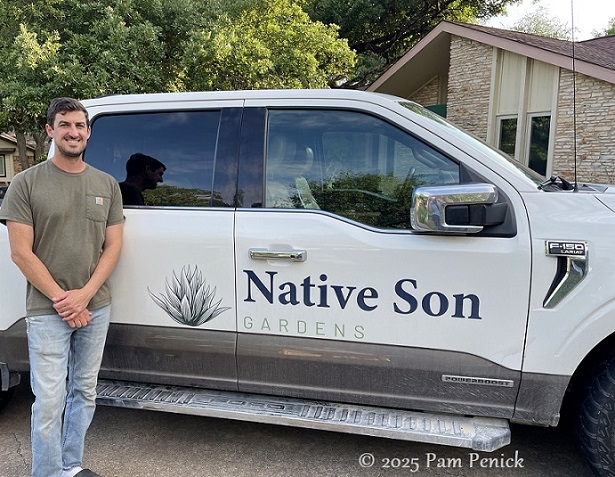
My thanks to Danny for sharing his garden with me — and for all that he’s doing on a nonprofit basis to beautify Austin’s schoolyards with native prairie gardens. Check out Plant Community to learn more about that work to green up schools. As their website points out, “Our children spend most of their waking lives at school, so let’s surround them with color, birdsong, butterflies, and areas to climb and play.” A fantastic goal! Native Son Gardens provides the labor and materials at cost for those projects. To learn more, attend their upcoming community fundraiser and school-garden tour on May 17th. More details here.
And check out Native Son Gardens for the inspiring, lawn-gone landscaping Danny’s company is doing, which starts with asking this question:
The resource intensive yards of the past are not sustainable, so we ask – what if your yard felt less like a “yard”, and more like an extension of our beautiful natural ecosystem?
His own garden is a beautiful example of what that can look like in Central Texas.
*One of Danny’s inspirations is the book Planting in a Post-Wild World by Thomas Rainer and Claudia West. Thomas Rainer gave a Garden Spark talk back in 2019, and I urge you to read his book if you are interested in ecology and urban streetscape design (it’s a little technical). It describes how we can use denser plantings, less mulch, and layered groundcovers to reduce maintenance, increase habitat for wildlife, help reduce the heat-island effect in cities, manage runoff, and beautify our urban areas and home gardens.
I welcome your comments. Please scroll to the end of this post to leave one. If you’re reading in an email, click here to visit Digging and find the comment box at the end of each post. And hey, did someone forward this email to you, and you want to subscribe? Click here to get Digging delivered directly to your inbox!
__________________________
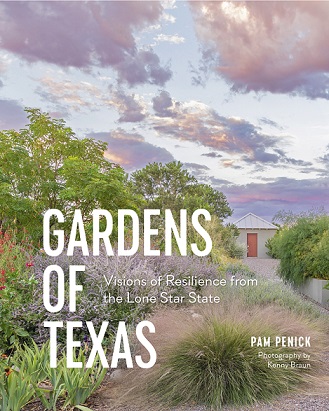
Digging Deeper
My new book, Gardens of Texas: Visions of Resilience from the Lone Star State, is available for pre-order at Amazon and other online book sellers. It’ll be released on October 14th, and while that’s several months away, pre-orders are tremendously helpful in getting my book noticed by readers and reviewers. Please consider pre-ordering if you’d like to read it this fall; more info here. Thank you for your support!
Come learn about gardening and design at Garden Spark! I organize in-person talks by inspiring designers, landscape architects, authors, and gardeners a few times a year in Austin. These are limited-attendance events that sell out quickly, so join the Garden Spark email list to be notified in advance; simply click this link and ask to be added. Read all about the Season 8 lineup here!
All material © 2025 by Pam Penick for Digging. Unauthorized reproduction prohibited.

